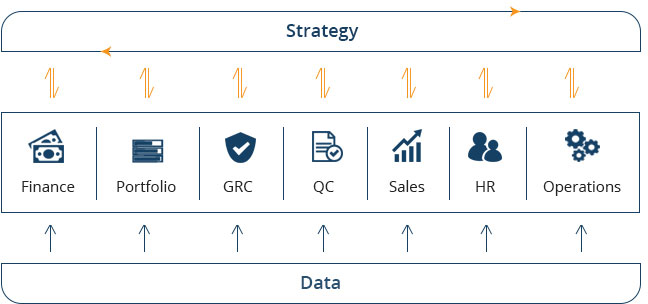It sounded like a low risk idea at the time: “Let’s forget about strategy for a while and escape to San Miguel, Mexico for a week of art lessons”. Little did I know that it would lead to a complete career change!
It was in the middle of the 2nd art lesson, when I was experimenting with different brushes, painting knives and other tools, that I realized that the tools I selected could make or break my ability to execute the painting I had planned. Maybe it was the change of pace or maybe it was the tequila, but my mind made a sudden connection back to a problem I’d been struggling to solve: “why organizations struggle with strategy execution?”
In my strategy consulting practice, I helped organizations define their desired business outcomes, perform analysis (on current performance, the micro/macro environment, the competition and more) and then create a plan to achieve the desired outcomes. But as you can see in the diagram below, there is one more critical step between planning and achieving outcomes: Execution.

In my quest to better understand the role of technology in strategy execution, I realized that most strategy software systems are simply data repositories to enable monthly check-ins to report on progress. In other words, they are “stuck” at the analysis phase versus enabling dynamic planning and execution to achieve outcomes. This meant that strategy is relegated to a “side of desk” periodic reporting activity rather than becoming part of the operational cadence of the business.
But it goes deeper than that. Even the few strategic software solutions that have some planning and execution functionality are typically limited to the “strategy layer”. But what about all the operational drivers of strategic outcomes? What about all the organizational silos of daily activity upon which strategy execution depends? (see the “Tactical Layer” in the Figure below).

Are organizations expected to find point-solutions for each silo or functional area and integrate them somehow? Why shouldn’t there be a single solution that can connect the strategy across the organization’s tactical silos and GROW with the organization’s needs?
For example, if an organization knows that a key process is critical to strategy but hasn’t implemented an operational system to manage and measure that process, wouldn’t it be great if the strategy solution could be configured to meet the exact tactical need (without costly vendor or IT programming support?)
What an epiphany! I began to seriously ponder the critical differences in strategy software systems. I had recently been exposed to Corporater and was surprised that there was a software which could do all this. I began to think of all the clients who could have gone further in their strategy execution if they’d a more robust solution set. If only I had known this over the years, I could have delivered even more value to my clients. After years of wrestling with “why strategy execution fails”, I’ve finally found the missing link and… I’m all in. Blame it on Mexico. I left my career to join Corporater and I’m putting my money where my mouth is. I now use BMP as CSO of Corporater to ensure we analyze, plan, EXECUTE, and achieve our business outcomes.
But don’t just take my word for it, here is what some of Corporater’s clients say: Testimonials
